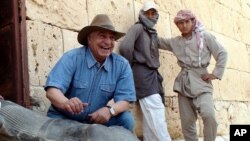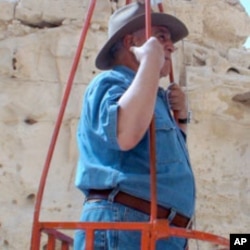They are among history's most famous lovers - Antony and Cleopatra, the Roman warrior and the Egyptian queen. From Shakespeare to Hollywood, their story has been told many times. Now, Egypt's top archeologist, with his own touch of Hollywood style, says he may be closing in on Cleopatra's tomb.
On a recent sunny day west of Alexandria, Zahi Hawass strides across the rock and rubble of Taposiris Magna, a Ptolemaic temple overlooking the shores of the Mediterranean. Wearing his trademark Indiana Jones hat, he explains that although others have scoured the temple before, this current dig, begun in 2005, has turned up countless new treasures.
He says the team has located the original main entrance and uncovered a series of pharaonic-style entrance blocks. There is also a statue, which Hawass, giving the headless torso a playful pat, says is likely that of Ptolemy IV, one of Cleopatra's ancestors. "That is really important discoveries " he says,"in the search for the beautiful, magical queen - Queen Cleopatra."
The idea of Taposiris as the burial place of Cleopatra and Mark Antony, who killed themselves rather than submit to Antony's rival Octavian, was proposed by a young Dominican archeologist, Kathleen Martinez. She tries to evoke the couple's last days, the end of Egypt as an empire. "She has to choose a place that she must be safe after life," she says, because "the Romans hated her so much, they will search for her body and they will destroy it."
Martinez notes that, significantly, the temple is dedicated to Isis and Osiris, ancient gods to whom the couple often compared themselves. But she says she is most excited about discovering a tunnel that bores straight down into bedrock. The team has devised a special winch that has already gone down 35 meters. She says she expects there will soon be "important news."
I ask if she will show us down the tunnel. She consults with Hawass, who decides to go himself. The improvised winch lowers the archeologist into the narrow, dark shaft.
And then it stops. The cables are twisted and Hawass is stranded 10-meters underground.
Workers, who only rigged the contraption a week before, struggle for a long 15 minutes to straighten the wires. One man grabs a rope as back-up. Onlookers resort to awkward banter, fixing blame for my suggestion. Then Hawass starts to spin himself around in the cramped space, untangling the cables.
The winch re-engages and the archeologist rises to the surface. In mock anger, he takes a menacing step toward me and pretends to land a punch.
The moment is vintage Hawass. It probably should have belonged to Martinez, but Hawass takes the spotlight. He fills the scene with genuine drama, makes his usually nervous employees only more so, and ends up providing the entertainment.
At 62, the Secretary General of Egypt's Supreme Council of Antiquities is going through his own Golden Age. Hawass is the top archeologist in arguably the world's richest archeological land, explorer-in-residence at the National Geographic Society, star of countless television programs, a prolific columnist and man-about-town.
Most recently, he has championed the return of ancient artifacts to their homelands, becoming a hero to others who have seen their heritage plundered. He can be shameless in his quest to get things back. He tells a story about a woman from Canada, who insisted on being repaid the 10,000 pounds sterling she spent on it. "I wrote her a letter to say that if she will keep this statue, the curse of the Pharaohs will rest on her," he says, adding that the next day, she handed the piece over.
He also takes pride in emphasizing the Egyptian, a parallel to Cleopatra - a Ptolemaic leader of Egyptian heritage who was the first to bother learning the local language. The archeologist is the first of his countrymen to be the international face of Egyptology, a field long dominated by Western Europeans. It is an image he feels important to project both abroad and at home.
He describes children coming up to him on the streets of Cairo, asking "'When are you sending the robot inside the pyramid?' And you have to know," he says, "there is a revival now among Egyptians loving their antiquities."
Not that mummies and pyramids are a hard sell. But his excitement and verve are catching and, on occasion, one suspects, overwhelming. I ask if his seemingly outsize persona ever poses a problem. "God gave me this talent," he says. "I will not tell him no."
It is a belief in self that lessens any surprise that his latest discoveries have an international tie-in. Next month, a major museum exhibit called Cleopatra: The Search for the Last Queen of Egypt, will open in the United States. And Hawass, with his enthusiasm, will be on hand.


